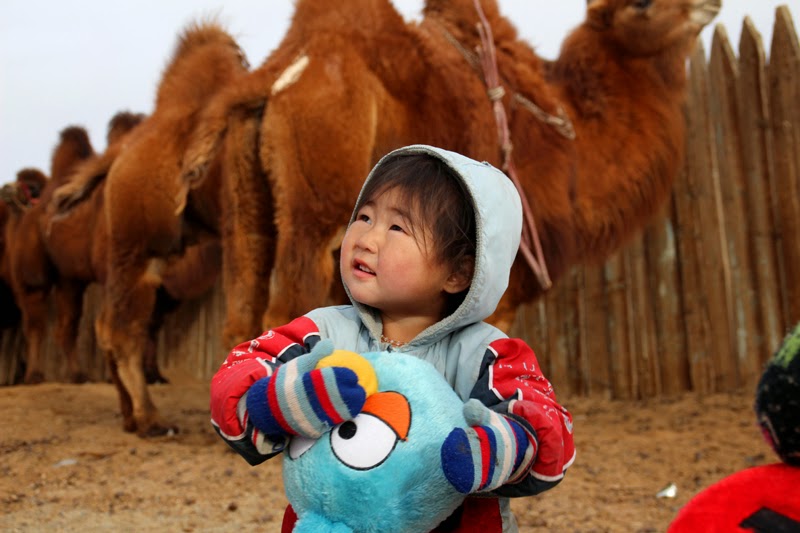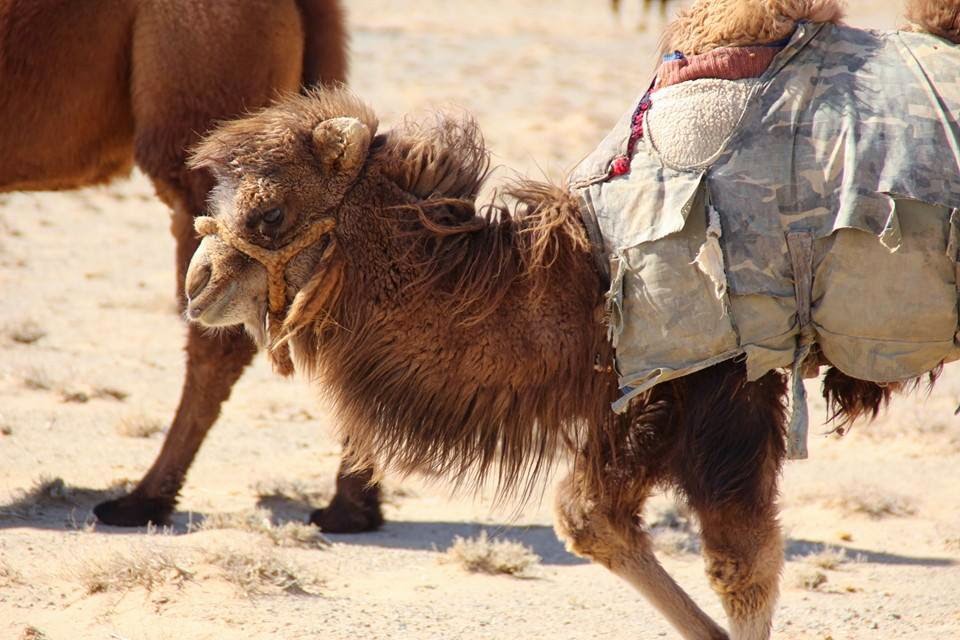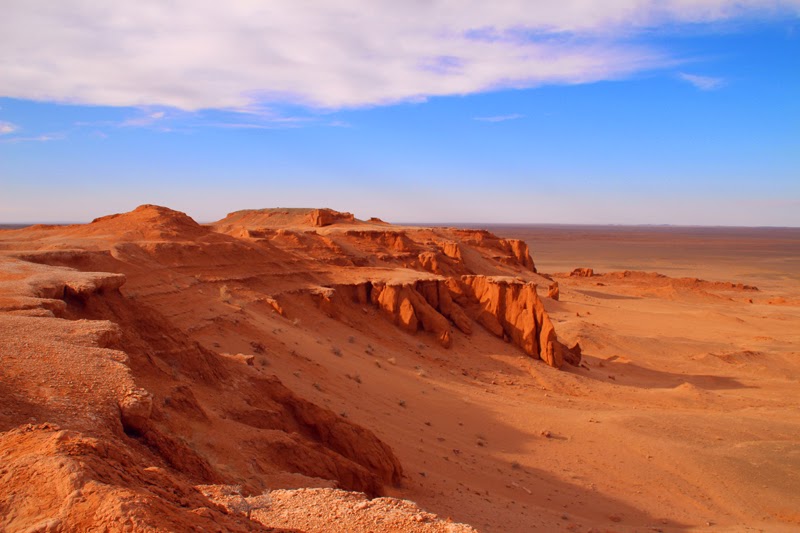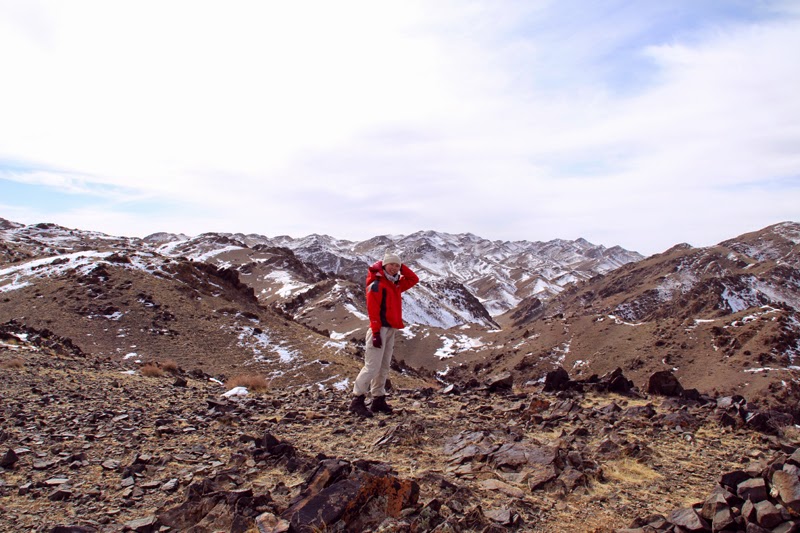My trip to the Gobi was a fairly typical one, in that I visited the usual tourists spots. What may not have been so typical was the season I chose to go in; indeed I didn't see any other foreigner throughout the entire week there. And for good reason, I suppose - this time of year it's cold and brown, as compared to summer when everything becomes lush. But the transition between winter and spring is beautiful in its own way.
Accommodation
A by-effect of visiting during off-season is that no tourist facility is open. I had to live like the locals do every day - we drew our own water for cooking and cleaning, chopped wood for the stove in the ger, used the outhouse (or hid behind an incline and hoped no one came by), and survived without a shower.
Looking up at the ceiling of the ger. There are eighty-eight radiating beams, with two struts for support, a chimney from the stove used for warmth and cooking, and a rope symbolising sturdiness.
Since the nomads rear lifestock, they invariably have a barn near their gers. This one housed baby goats who curiously came over to take a peek at us.
The benefit of being in the middle of nowhere - need I say more!
This simple structure is amazing at trapping heat - it was ten below zero outside, but I was sweating even in my underwear.
In a rural town, before we left for the wilderness. Townspeople have to fetch their own water for their daily activities. Those who have cars come in their cars; others come pushing their jerry cans on trolleys; yet others carry them by hand. They are a tough lot.
No electricity - in this photo I remember I was sitting outside to catch the last rays of the setting sun.
The spartan interior of the guest ger. The family's adjacent ger had satellite television, and when I popped in to chat, they were watching the latest episode of a Korean drama. :)
An outhouse. This is something that will take some getting used to. It's basically a little shed built over a three-metre deep hole, and should it so take your fancy and you look down, there will be a massive stalagmite of human poop. The smell that wafts up is incredible. The majority of outhouses I saw there had only three walls, so your bottom is exposed to the whipping winds. There is, of course, no lights, so you want to avoid coming here at night for fear of falling in.
The baby of the camel-herder family.
So cute with her rosy little cheeks.
Baby animals everywhere we went! Some still learning to stand and others stumbling around on their new-found wobbly legs.
The herders go out amongst their flocks every day and collect the newborn in a sack. They bring the babies back to the barn where they're better protected against the elements and have a higher chance of surviving.
On the road
The distances between point to point to are huge; we spent six hours a day - or more - on travelling. But none of that was time wasted, because the scenery was stunning - you get to see how the steppes merge with the mountains and the sand dunes - and there are so many surprises along the way. It could be in the way the sun breaks through the clouds and shines a golden cast over the land. Or the hundreds of gazelles that pop out of nowhere and spring away in puffs of dust. Or the way the weather changes so suddenly that sunshine becomes snowfall in a matter of minutes.
Gazelles! The day after an unexpectedly heavy localised snowfall, I remember seeing thousands and thousands of wild gazelles on the plains. Apparently the combination of snow and budding grass had brought them out for food and water. It was incredible to see so many of these shy animals up close.
Lone horse watching us from the steppes.
Mongolian horses are much smaller than their Western counterparts, but they're very strong and sturdy.
Pit stop for me to wander off and take photos.
A baby camel!
Stopping for lunch in the middle of nowhere.
Yolyn Am
Yolyn Am is a gorge in the Gurvan Saikhan Mountains. The name translates commonly to Eagle Valley, but in truth it's named after a small vulture that we saw many times along the roadside throughout the trip.
Frozen waterfall in an adjacent valley.
Snow just beginning to fall. On our way back out the wind and snow picked up - I turned back to take a last look at the valley, but could only see the swirls of snow.
Picking our way carefully up the ice path in Yolyn Am. The way back down was much easier - sit and slide!
Khongoryn Els and camel herder family
I got the chance to climb a sand dune and ride a camel! My only regret is that I didn't climb the dunes at sunset or sunrise, but at that point of time I simply couldn't bring myself to do it again.
I loved how you can see all three landscapes at once - mountains, desert, steppes.
At the base of the sand dune, still naively optimistic.
Driving alongside the dunes.
Sunset at the camel pen!
The family there herds sheep and goats as well.
The camel is such a gentle, loving animal! It leaned into my hand as I rubbed it on the side of its head - very much like how my dog used to respond. :) Beautiful animal with a great temperament.
Off for a ride along the dunes.
Bayanzag Flaming Cliffs
The cliffs became famous due to the discovery of numerous dinosaur fossils since the 1920s. No, you probably won't find anything there (I tried very hard), but it's still a nice place to visit, particularly at sunset. The ground is much softer and clayey than the surrounding areas, so mind your step.
Khavtsgait Petroglyphs
The petroglyphs are found in the middle of a range of mountains. There are thousands of rock fragments lying around, and as you pick your way through them, look carefully - some have engravings of horses, deer, camels, or even humans on them, made by the early Gobi settlers in the Bronze Age.
View from the top, overlooking the plains. As I climbed the mountain, I was torn between looking up at the view, or down at the petroglyphs!
At the end of the trip, I only wished I had more time to spend in this magical country. What I've been privileged to see is only a tiny fraction of what Mongolia really is. Another trip is is due - Jared? Dad? Anyone? :)


.jpg)

























.jpg)




















No comments:
Post a Comment